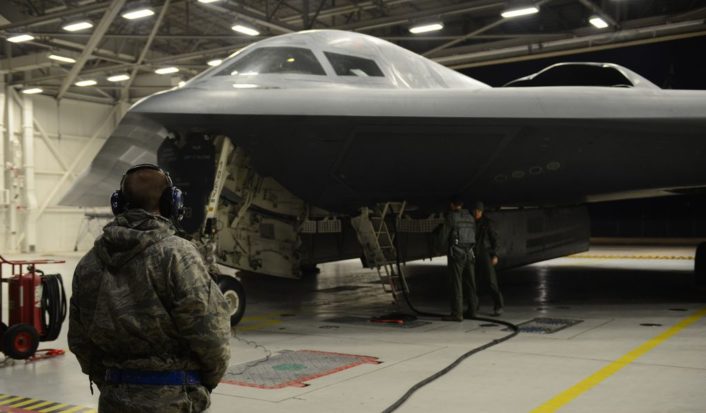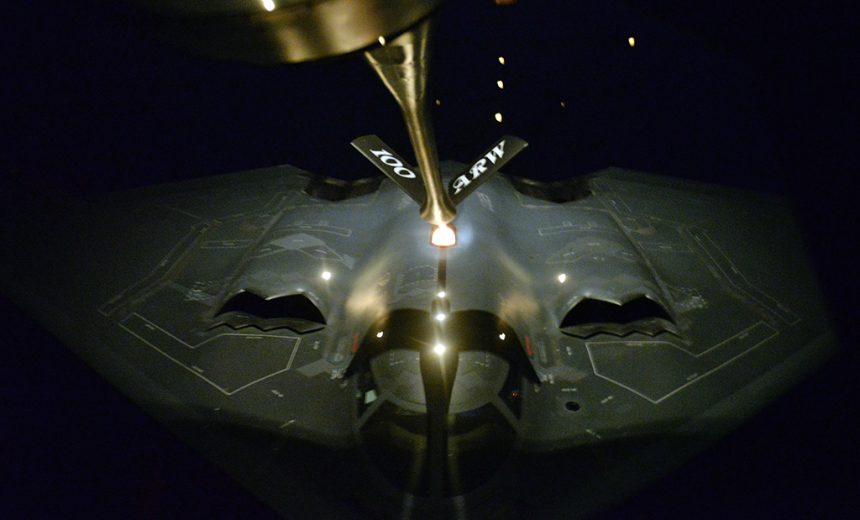In a massive two-aircraft nighttime precision strike supported by at least one armed drone U.S. Air Force stealth bombers have killed over 80 ISIL insurgents south of the coastal city of Sirte, Libya.
As already reported, two U.S. Air Force B-2 Spirit bombers from the 509th Bomb Wing at Whiteman Air Force Base carried out a precision air strike on Daesh training camps in Libya on Jan. 18, 2017.
DoD officials characterized the strike as a “huge success” in a statement issued on Jan. 19.
The multiple terrorist camps struck on Wednesday were once an ISIL stronghold in Libya. The targets were hit with 108 precision-targeted, air-delivered weapons. There was no indication of how the targeting data was provided. Following the airstrike by B-2s at least one remotely piloted vehicle (MQ-9 Reaper according to some sources, MQ-1 Predator according to others) launched supporting strikes using AGM-114 Hellfire missiles against ISIS fighters trying to run to safety.
“In conjunction with the Libyan Government, the U.S. military conducted precision airstrikes Wednesday night destroying two ISIL camps 45 kilometers southwest of Sirtem,” Pentagon press secretary Peter Cook told reporters.
This continuation of U.S. air action over Libya further extends U.S. combat operations in the region bringing the number of airstrikes by U.S. forces to nearly 500.
This latest round of heavy strikes was authorized by outgoing U.S. President Barack Obama, indicating that the targets were of significant strategic value to the conflict. The camps were established by ISIL insurgents following a protracted combined ground and air campaign by a coalition of nations including Libya to eliminate the terrorist influence in the region.
The strikes were flown from the continental United States directly to Libya and back but, unlike what happened in 2011, during the opening phases of Operation Odyssey Dawn, the raid was far from being unnoticed: the aircraft flew under radio callsign CLIP11 (93-1087) CLIP12 (89-0129) and CLIP13 (82-1068) with the latter one being the spare aircraft.
According to some sources, a fourth B-2 was involved in the raid but only three were monitored by airband listeners and this would be coherent with the standard Spirit procedures that usually involve a single spare aircraft.
ATC clearence for USAF B-2A (cs Clip11flt). 4750n50w 4750n45w 47n3640w 47n35w 4609n30w 4514n25w 44n22w 4130n20w DETOX and back on cource. pic.twitter.com/C3jn6P1GZC
— Mark (@Mark_swl) January 18, 2017
A total of 15 tankers (KC-135 and KC-10) participated in the operation, enabling the B-2s to fly the more than 30 hours round-trip to the target from their home base in Missouri.
According to the U.S. Air Force, planners at 18th Air Force and the 618th Air Operations Center at Scott AFB coordinated the tanker mission.
The 305th Air Mobility Wing at Joint Base McGuire-Dix-Lakehurst, New Jersey, was one of the units that contributed tankers to the refueling mission. Then, after crossing the Pond, the B-2s were refueled off Gibraltair by KC-135s belonging to the 100th ARW launched from RAF Mildenhall, UK, whose racetracks could be tracked online by means of ADS-B.
#REACH flights supporting #B2 global power mission #potn pic.twitter.com/t1QmtHUZUu
— Planes on the net (@planesonthenet) January 19, 2017
The USS Donald Cook (DDG-75) and USS Porter (DDG-78), both Arleigh-Burke class guided missile destroyers, supported the operation as they steamed north of Libya on station in the Mediterranean.
According to Defense journalist Babak Taghvaee, ISR (Intelligence Surveillance Reconnaissance) and post-strike BDA (Battle Damage Assessment) were conducted by U-28A aircraft from 319th SOS even though the participation of USAF RQ-4 Global Hawk drones, that have often conducted missions over North Africa and Syria seems to be quite likely.

The B-2 Spirit is a unique asset to the American military, with no comparable low-observable, heavy precision strike asset being fielded by any other nation. The aircraft became operational in early 1997 and launched its first combat strike soon after in KosTwo B-2 Spirit stealth bombers from the 509th Bomb Wing at Whiteman Air Force Base carried out a precision air strike in Libya on Jan. 18, 2017.ovo in 1999. There are fewer than twenty of the aircraft in Air Force inventory.

The B-2 Spirit is operated by the legacy 509th Bomb Wing at Whiteman AFB in Knob Noster, Missouri. The 509th Bomb Wing was originally formed in late WWII expressly to conduct the first operational nuclear strikes on Japan in 1945. The unit operated a modified version of the Boeing B-29 Superfortress and launched two operational nuclear strikes on Hiroshima and Nagasaki, the only active use of nuclear weapons by a nation in warfare.
Written with David Cenciotti
















